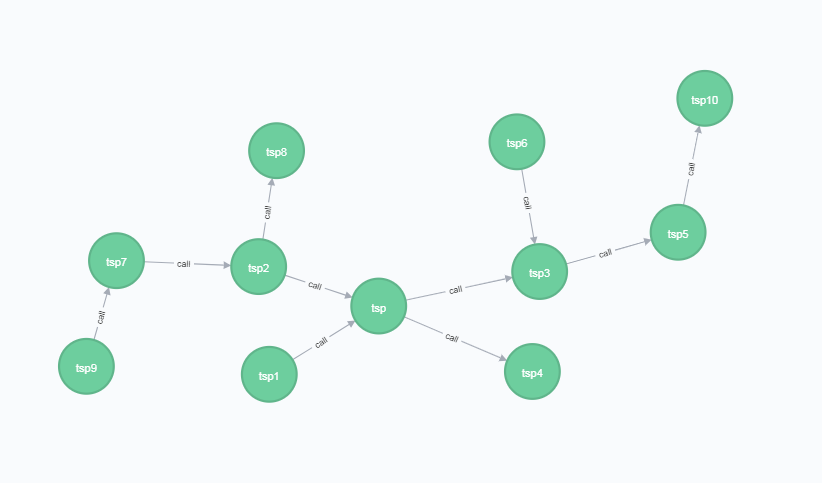spring boot 2.0 neo4j 使用
参考文档
官方文档
- http://spring.io/projects/spring-data-neo4j#learn
- https://docs.spring.io/spring-data/neo4j/docs/5.1.2.RELEASE/reference/html/
- https://neo4j.com/docs/
- https://neo4j.com/docs/developer-manual/current/
第三方使用文档
- https://blog.csdn.net/appleyk/article/category/7408344 系列文档
- https://blog.csdn.net/u013946356/article/details/81739079
中文手册(比较滞后)
- https://www.w3cschool.cn/neo4j/
安装 maven 包
<dependency>
<groupId>org.neo4j</groupId>
<artifactId>neo4j-ogm-http-driver</artifactId>
<version>3.1.4</version>
</dependency>
<dependency>
<groupId>org.springframework.boot</groupId>
<artifactId>spring-boot-starter-data-neo4j</artifactId>
<version>2.1.0.RELEASE</version>
</dependency>
添加 neo4j 配置
application.yml
spring:
data:
neo4j:
username: neo4j
password: 1234
uri: http://172.16.235.175:7474
添加配置类
@Configuration
@EnableNeo4jRepositories(basePackages = "com.example.demo.repository")
@EnableTransactionManagement
public class Neo4jConfig { @Value("${spring.data.neo4j.uri}")
private String databaseUrl; @Value("${spring.data.neo4j.username}")
private String userName; @Value("${spring.data.neo4j.password}")
private String password; @Bean
public SessionFactory sessionFactory() {
org.neo4j.ogm.config.Configuration configuration = new org.neo4j.ogm.config.Configuration.Builder()
.uri(databaseUrl)
.credentials(userName, password)
.build();
return new SessionFactory(configuration, "com.example.demo.entity");
} @Bean
public Neo4jTransactionManager transactionManager() {
return new Neo4jTransactionManager(sessionFactory());
}
}
添加 Neo4j 节点类
@NodeEntity
public class SGNode {
private Long count;
private Long error;
private Double max;
private Double min; /**
* Neo4j会分配的ID(节点唯一标识 当前类中有效)
*/
@Id
@GeneratedValue
private Long id; private String name; public Long getId() {
return id;
} public void setId(Long id) {
this.id = id;
} public String getName() {
return name;
} public void setName(String name) {
this.name = name;
} @Relationship(type = "call")
private List<CallRelation> calls; public SGNode() {
count = 0L;
error = 0L;
max = 0.0;
min = 0.0;
calls = new ArrayList<>();
} public SGNode(String name) {
this();
this.name = name;
} public Long getCount() {
return count;
} public void setCount(Long count) {
this.count = count;
} public Long getError() {
return error;
} public void setError(Long error) {
this.error = error;
} public Double getMax() {
return max;
} public void setMax(Double max) {
this.max = max;
} public Double getMin() {
return min;
} public void setMin(Double min) {
this.min = min;
} public List<CallRelation> getCalls() {
return calls;
} public void setCalls(List<CallRelation> calls) {
this.calls = calls;
} public void addCalls(SGNode node, Long count) {
CallRelation relation = new CallRelation(this, node, count);
this.calls.add(relation);
}
}
添加 Neo4j 关系类
@RelationshipEntity(type = "call")
public class CallRelation { public CallRelation() {
this.name = "call";
} public CallRelation(SGNode start, SGNode end, Long count) {
this();
this.startNode = start;
this.endNode = end;
this.count = count;
} /**
* Neo4j会分配的ID(节点唯一标识 当前类中有效)
*/
@Id
@GeneratedValue
private Long id; private String name; public Long getId() {
return id;
} public void setId(Long id) {
this.id = id;
} public String getName() {
return name;
} public void setName(String name) {
this.name = name;
} /**
* 定义关系的起始节点 == StartNode
*/ @StartNode
private SGNode startNode; /**
* 定义关系的终止节点 == EndNode
*/ @EndNode
private SGNode endNode; /**
* 定义关系的属性
*/ @Property(name = "count")
private Long count; public SGNode getStartNode() {
return startNode;
} public void setStartNode(SGNode startNode) {
this.startNode = startNode;
} public SGNode getEndNode() {
return endNode;
} public void setEndNode(SGNode endNode) {
this.endNode = endNode;
} public Long getCount() {
return count;
} public void setCount(Long count) {
this.count = count;
}
}
添加 Reponsitory
@Repository
public interface SGNodeReponsitory extends Neo4jRepository<SGNode, Long> {
// 此处用法可见 https://docs.spring.io/spring-data/neo4j/docs/5.1.2.RELEASE/reference/html/#_query_methods
SGNode findByName(@Param("name") String name);
}
使用 Demo
@RestController
@RequestMapping("/sg")
public class SGNodeController { @Autowired
SGNodeReponsitory sgNodeReponsitory; @DeleteMapping("/delete")
public String delete() {
sgNodeReponsitory.deleteAll();
return "OK";
} @GetMapping("/add")
public String add() {
addNodes();
return "OK";
} @GetMapping("/get")
public String relation() {
SGNode node = sgNodeReponsitory.findByName("tsp");
List<Long> ids = new ArrayList<>();
ids.add(node.getId());
Iterable<SGNode> result = sgNodeReponsitory.findAllById(ids, 1);
return "OK";
} private void addNodes() {
sgNodeReponsitory.deleteAll(); List<SGNode> list = new ArrayList<>(); SGNode node = new SGNode("tsp");
list.add(node); for (Integer i = 1; i <= 10; i++) {
node = new SGNode("tsp" + i);
node.setCount(new Random().nextLong());
node.setError(new Random().nextLong());
node.setMax(new Random().nextDouble());
node.setMin(new Random().nextDouble());
list.add(node);
} sgNodeReponsitory.saveAll(list); SGNode start = sgNodeReponsitory.findByName("tsp1");
SGNode end = sgNodeReponsitory.findByName("tsp");
start.addCalls(end, new Random().nextLong());
sgNodeReponsitory.save(start); start = sgNodeReponsitory.findByName("tsp2");
end = sgNodeReponsitory.findByName("tsp");
start.addCalls(end, new Random().nextLong());
sgNodeReponsitory.save(start); start = sgNodeReponsitory.findByName("tsp9");
end = sgNodeReponsitory.findByName("tsp7");
start.addCalls(end, new Random().nextLong());
sgNodeReponsitory.save(start); start = sgNodeReponsitory.findByName("tsp7");
end = sgNodeReponsitory.findByName("tsp2");
start.addCalls(end, new Random().nextLong());
sgNodeReponsitory.save(start); start = sgNodeReponsitory.findByName("tsp2");
end = sgNodeReponsitory.findByName("tsp8");
start.addCalls(end, new Random().nextLong());
sgNodeReponsitory.save(start); start = sgNodeReponsitory.findByName("tsp");
end = sgNodeReponsitory.findByName("tsp3");
start.addCalls(end, new Random().nextLong());
sgNodeReponsitory.save(start); start = sgNodeReponsitory.findByName("tsp");
end = sgNodeReponsitory.findByName("tsp4");
start.addCalls(end, new Random().nextLong());
sgNodeReponsitory.save(start); start = sgNodeReponsitory.findByName("tsp6");
end = sgNodeReponsitory.findByName("tsp3");
start.addCalls(end, new Random().nextLong());
sgNodeReponsitory.save(start); start = sgNodeReponsitory.findByName("tsp3");
end = sgNodeReponsitory.findByName("tsp5");
start.addCalls(end, new Random().nextLong());
sgNodeReponsitory.save(start); start = sgNodeReponsitory.findByName("tsp5");
end = sgNodeReponsitory.findByName("tsp10");
start.addCalls(end, new Random().nextLong());
sgNodeReponsitory.save(start);
}
}
执行 Add 操作之后

spring boot 2.0 neo4j 使用的更多相关文章
- Spring Boot 2.0官方文档之 Actuator(转)
执行器(Actuator)的定义 执行器是一个制造业术语,指的是用于移动或控制东西的一个机械装置,一个很小的改变就能让执行器产生大量的运动. An actuator is a manufacturin ...
- springboot2.0(一):【重磅】Spring Boot 2.0权威发布
就在昨天Spring Boot2.0.0.RELEASE正式发布,今天早上在发布Spring Boot2.0的时候还出现一个小插曲,将Spring Boot2.0同步到Maven仓库的时候出现了错误, ...
- 业余草分享 Spring Boot 2.0 正式发布的新特性
就在昨天Spring Boot2.0.0.RELEASE正式发布,今天早上在发布Spring Boot2.0的时候还出现一个小插曲,将Spring Boot2.0同步到Maven仓库的时候出现了错误, ...
- Spring Boot 2.0(二):Spring Boot 2.0尝鲜-动态 Banner
Spring Boot 2.0 提供了很多新特性,其中就有一个小彩蛋:动态 Banner,今天我们就先拿这个来尝尝鲜. 配置依赖 使用 Spring Boot 2.0 首先需要将项目依赖包替换为刚刚发 ...
- Spring Boot 2.0(四):使用 Docker 部署 Spring Boot
Docker 技术发展为微服务落地提供了更加便利的环境,使用 Docker 部署 Spring Boot 其实非常简单,这篇文章我们就来简单学习下. 首先构建一个简单的 Spring Boot 项目, ...
- spring boot 2.0.0由于版本不匹配导致的NoSuchMethodError问题解析
spring boot升级到2.0.0以后,项目突然报出 NoSuchMethodError: org.springframework.boot.builder.SpringApplicationBu ...
- Spring Boot 2.0(六):使用 Docker 部署 Spring Boot 开源软件云收藏
云收藏项目已经开源2年多了,作为当初刚开始学习 Spring Boot 的练手项目,使用了很多当时很新的技术,现在看来其实很多新技术是没有必要使用的,但做为学习案例来讲确实是一个绝佳的 Spring ...
- Spring Boot 2.0系列文章(五):Spring Boot 2.0 项目源码结构预览
关注我 转载请务必注明原创地址为:http://www.54tianzhisheng.cn/2018/04/15/springboot2_code/ 项目结构 结构分析: Spring-boot-pr ...
- Spring Boot 2.0系列文章(七):SpringApplication 深入探索
关注我 转载请务必注明原创地址为:http://www.54tianzhisheng.cn/2018/04/30/springboot_SpringApplication/ 前言 在 Spring B ...
随机推荐
- Python——Pycharm安装、激活、中文、
1.激活pycharm (1) 修改hosts文件:将 0.0.0.0 account.jetbrains.com 添加到文件最后面 Windows系统hosts文件路径为: c:\win ...
- HDU 2571 命运(简单dp)
传送门 真是刷越多题,越容易满足.算是一道很简单的DP了.终于可以自己写出来了. 二维矩阵每个点都有一个幸运值,要求从左上走到右下最多能积累多少幸运值. 重点就是左上右下必须都踩到. dp[i][j] ...
- Nginx 处理Http请求简单流程
L45 1:三次握手后 系统内核收到请求根据端口负载均衡的分配到某个worker 2:nginx 会分配一个512byte链接内存池 3:初始化nginx的http模块并等待用户请求,假设用户在cli ...
- 【XSY2903】B 莫比乌斯反演
题目描述 有一个\(n\times n\)的网格,除了左下角的格子外每个格子的中心里都有一个圆,每个圆的半径为\(R\),问你在左下角的格子的中心能看到多少个圆. \(n\leq {10}^9,R_0 ...
- 2.2 collection 模块
2.2.1 定义命名元祖 2.2.2 定义双端队列 2.2.3 定义有序的字典 2.2.4 定义有默认值的字典
- [powershell] 批量重命名,修改文件名中的部分字符串
实例:替换一个目录下所有的字幕文件从720p到1080p ls $Path -Recurse |ForEach-Object{Rename-Item $_.FullName $_.FullName.R ...
- java 11 ZGC(可伸缩,低延迟的gc)
ZGC, A Scalable Low-Latency Garbage Collector(Experimental) 可伸缩,低延迟的gc ZGC, 这应该是JDK11最为瞩目的特性, 没有之一. ...
- Redmine简易安装与系统优化
安装版本为bitnami-redmine-2.6.5-0 ,用的Bitnami的一键安装包 . 下载地址https://bitnami.com/stack/redmine/installer 简要安装 ...
- 【洛谷P1134 阶乘问题】
[传送门] #include<bits/stdc++.h> using namespace std; int main() { ; cin>>a; ;i<=a;i++) ...
- 使用Redisson实现分布式锁,Spring AOP简化之
源码 Redisson概述 Redisson是一个在Redis的基础上实现的Java驻内存数据网格(In-Memory Data Grid).它不仅提供了一系列的分布式的Java常用对象,还提供了许多 ...
